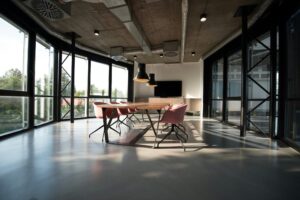Budgeting Tips for Office Fit-Out
Budgeting is a crucial aspect of any office fit-out project. It helps ensure that the project stays on track financially and that resources are allocated efficiently. Without a budget, it is easy for costs to spiral out of control and for the project to exceed its intended scope. We will explore the importance of budgeting for office fit-out projects and provide tips and strategies for creating and managing a realistic budget.
The purpose is to help office managers, project managers, and business owners understand the significance of budgeting for office fit-out projects. By understanding the benefits of budgeting, identifying areas for cost savings, creating a realistic budget, prioritizing needs, negotiating effectively, maximizing the value of the investment, managing unexpected costs, leveraging technology, tracking expenses, and evaluating the success of the budgeting strategy, you will be equipped with the knowledge and tools necessary to successfully manage your office fit-out project for a cost-effective workplace transformation.
Understanding the Importance of Budgeting for Office Fit Out
Budgeting is essential for office fit out projects for several reasons. Firstly, it helps ensure that the project stays within financial constraints. By setting a budget at the beginning of the project, you can allocate resources accordingly and avoid overspending. This is particularly important for small businesses or startups with limited financial resources.
Secondly, budgeting allows you to plan and prioritize your office fit out needs based on the type of categories of fit out that you plan to invest. By setting a budget, you can determine which aspects of the project are most important and allocate funds accordingly. This helps prevent unnecessary spending on non-essential items or features.
Lastly, budgeting helps you track expenses and stay on schedule. By monitoring your spending throughout the project, you can identify any areas where costs are exceeding expectations and take corrective action. This ensures that the project stays on track and is completed within the allocated timeframe.
On the other hand, not having a budget for your office fit out project can lead to several risks. Without a budget, it is easy for costs to spiral out of control and for the project to exceed its intended scope. This can result in financial strain and delays in completing the project. Additionally, without a budget, it is difficult to prioritize needs and allocate resources effectively, which can lead to a subpar end result.

Creating a Realistic Budget for Your Office Fit-Out Project
Creating a realistic budget for your office fit-out project involves several steps. Firstly, you need to determine the scope of the project and identify all the necessary components. This includes furniture, fixtures, equipment, materials, labor costs, and any additional expenses such as permits or licenses.
Next, research the market to get an idea of the average costs associated with each component. This will help you set realistic expectations and avoid overestimating or underestimating costs. Consider reaching out to suppliers or contractors for quotes to get a better understanding of the costs involved.
Once you have gathered all the necessary information, create a detailed budget that includes all the components and associated costs. Be sure to include a contingency fund to account for any unexpected expenses that may arise during the project.
When creating a budget, it is important to be realistic and flexible. Be prepared to make adjustments as needed and be open to alternative options that may help reduce costs without compromising on quality.
Prioritizing Your Office Fit-Out Needs to Stay Within Budget
Prioritizing your office fit-out needs is crucial to staying within budget. By determining which aspects of the project are most important, you can allocate funds accordingly and avoid overspending on non-essential items.
Start by identifying the core needs of your office fit-out project. This includes essential furniture, fixtures, and equipment that are necessary for the day-to-day operations of your business. Once these core needs have been met, you can then allocate funds to secondary or non-essential items.
Consider conducting a cost-benefit analysis for each component of the project. This involves evaluating the potential benefits or returns on investment for each item and weighing them against the associated costs. This will help you prioritize items that offer the greatest value for money and allocate funds accordingly.
Additionally, consider the long-term implications of your decisions. While it may be tempting to cut costs in the short term, it is important to consider the long-term impact on productivity, employee satisfaction, and overall business operations. Sometimes investing a little more upfront can result in significant cost savings or benefits in the long run.
Maximizing the Value of Your Office Fit-Out Investment
Maximizing the value of your office fit-out investment involves making strategic decisions that offer the greatest return on investment. By focusing on areas that have the greatest impact on productivity, employee satisfaction, and overall business operations, you can ensure that your investment is well-spent.
One way to maximize the value of your investment is by investing in quality furniture and fixtures that are durable and long-lasting. While this may require a larger upfront investment, it can result in significant cost savings in the long run by reducing the need for frequent replacements or repairs.
Additionally, consider investing in technology that can improve efficiency and productivity. This includes tools or software that streamline processes, automate tasks, or improve communication and collaboration. By investing in technology that aligns with your business needs, you can save time and resources while improving overall operations.
Furthermore, consider the layout and design of your office space and how it can be optimized for maximum efficiency. This includes creating designated areas for different tasks or functions, providing ample storage space, and ensuring that the space is comfortable and conducive to productivity.
Strategies for Managing Unexpected Costs During Office Fit-Out
Managing unexpected costs is an important aspect of budgeting for office fit-out projects. While it is impossible to predict or prevent all unexpected costs, there are strategies you can implement to minimize their impact and ensure that your project stays on track financially.
Firstly, include a contingency fund in your budget. This is a separate fund that is set aside specifically for unexpected expenses that may arise during the project.
The general rule of thumb is to allocate around 10-20% of the total project cost to the contingency fund.
Next, conduct a thorough risk assessment before starting the project. This involves identifying potential risks or challenges that may arise and developing strategies to mitigate or manage them. By being proactive and prepared, you can minimize the likelihood and impact of unexpected costs.
Additionally, communicate openly and regularly with your contractors and suppliers. Keep them informed of any changes or challenges that may arise during the project and work together to find solutions. By maintaining a strong relationship with your contractors and suppliers, you can often negotiate better terms or find alternative options when unexpected costs arise.
Tracking Expenses and Staying on Budget Throughout the Project
Tracking expenses is crucial to staying on budget throughout your office fit-out project. By monitoring your spending regularly, you can identify any areas where costs are exceeding expectations and take corrective action.
Start by setting up a system for tracking expenses. This can be as simple as using a spreadsheet or as sophisticated as using budgeting software. The key is to have a system in place that allows you to record and categorize expenses accurately and efficiently.
Next, establish a regular schedule for reviewing and analyzing your expenses. This can be done weekly, bi-weekly, or monthly, depending on the size and complexity of your project. During these reviews, compare your actual expenses against your budgeted amounts and identify any discrepancies or areas where costs are exceeding expectations.
When reviewing your expenses, be proactive in identifying potential cost-saving opportunities. Look for areas where you can reduce costs without compromising on quality or functionality. This may involve renegotiating contracts, exploring alternative suppliers or contractors, or finding creative solutions to minimize expenses.
Lastly, communicate regularly with your team members, contractors, and suppliers about the budget and any changes or challenges that may arise. By maintaining open lines of communication, you can ensure that everyone is aware of the budgetary constraints and can work together to stay on track financially.
Evaluating the Success of Your Office Fit-Out Budgeting Strategy
Evaluating the success of your office fit-out budgeting strategy is an important step in the process. By assessing the effectiveness of your budgeting strategy, you can identify areas for improvement and make adjustments for future projects.
Start by comparing your actual expenses against your budgeted amounts. Calculate the variance for each component of the project and identify any significant discrepancies. This will help you understand where your budgeting strategy was successful and where it fell short.
Next, evaluate the overall financial performance of the project.
By answering these questions, you can gain valuable insights into the effectiveness of your budgeting strategy.
Additionally, consider gathering feedback from team members, contractors, and suppliers involved in the project. Ask for their input on the budgeting process and any areas where improvements could be made. This will help you gain different perspectives and identify blind spots or areas for improvement.
Lastly, document your findings and lessons learned from the project. This will serve as a valuable resource for future projects and help you refine your budgeting strategy over time.
Find this content helpful. Get in touch with our team of experts now!
Related stories
Around half of all Facilities Managers plan to downsize their office space in the next three years. Our recent survey, conducted across the U.K., U.S., Singapore, India, New Zealand, and Hong Kong, interviewed over one thousand office workers and facilities managers to explore changing office habits and attitudes.
In our recent article, “Is it time for offices to get personal again?” we discussed the importance of personal workspace environments for productivity and morale. There’s another aspect office designers and facilities managers need to address urgently: technology. Modern workplaces face a particularly post-COVID conundrum: Employees finding their home setup better equipped, and more comfortable, […]
The open office was sold as the modern solution to just about any workplace problem for decades now: siloed workers? Open them up (literally) to collaboration. Bad communication? Put everyone in a big room. Worried about productivity? Create a vantage point. And so, walls came down, spaces opened up, and collaboration was supposed to flourish. […]



























